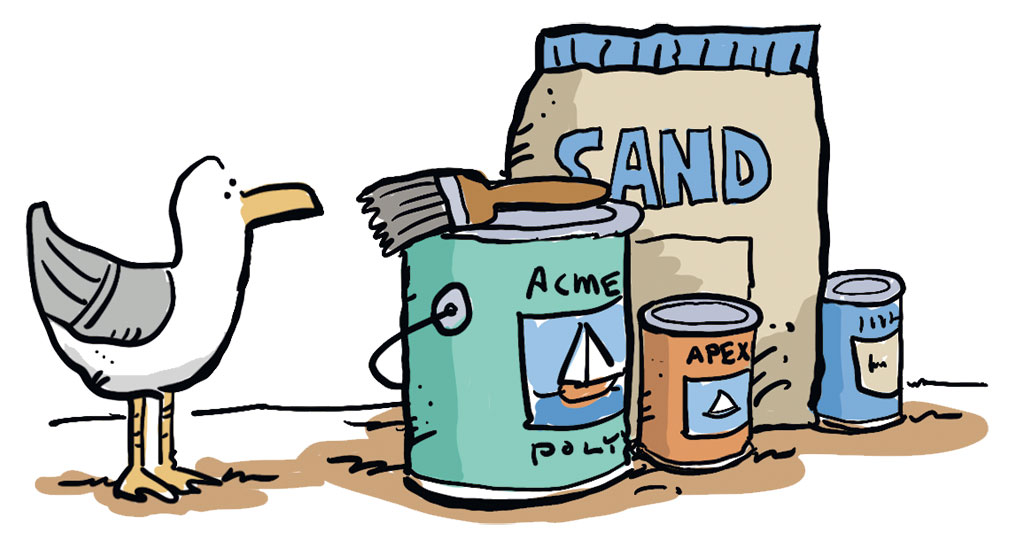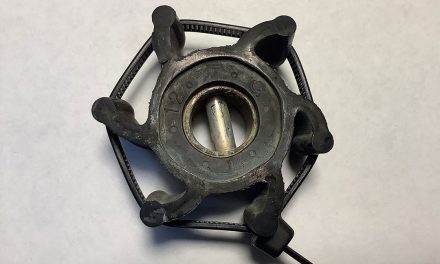The DIY deck paint job looked fantastic. Then the surveyor showed up.
Toward the end of a 13-month refit, my 1968 Santana 22 was looking pretty spiffy. Just the decks remained to be painted. By this time, I was well aware that there is no such thing as a quick fix aboard a boat, so I was quite resigned to doing everything necessary to thoroughly prepare the decks for painting.
I washed them with fresh water with a little detergent in it. I let them dry and wiped them down with a rag soaked in acetone. I sanded them lightly by hand and carefully brushed them clean. I washed them again with fresh water and let them dry.
At the boating store, I paid a small fortune for some Interlux Perfection topcoat, a two-part linear polyurethane. I tried to buy some Interlux epoxy prime coat to go with it, but the store was out. So, working on the premise that epoxy is epoxy, no matter the label, I bought a different brand of epoxy sanding surface primer, and one that happened to claim to be especially good for crazed gelcoat like mine. It was a brand I recognized, so I knew it would be fine.
Back at the boat, I spent a tedious afternoon fitting little bits of blue masking tape around the windows and a host of deck fittings. The next day, I brushed on my two-part epoxy primer coat, allowed it to cure, and gave it a gentle sanding. I brushed it clean before applying the two-part Perfection topcoat. As I painted, I sprinkled 30-grit sand (kiln-dried and sifted) liberally on top. I let the paint cure, then carefully brushed off the sand that wasn’t stuck to the paint.
I brushed another topcoat over the sand. I let it cure. I brushed another topcoat over the topcoat.
I removed all the bits of masking tape before the fast-curing paint could stick it fast to the deck.
It was a magnificent job, striking to behold, a gorgeous nonskid surface in light grey.
Then came the great day when the surveyor arrived to check the boat for the insurance company.
Tap, tap, tap. Long silence.
“John?”
“Yeah?”
“Your deck is delaminating.”
“What? No, it can’t be! I just painted it!”
“Listen to this,” he said, tapping his diabolical little hammer on the foredeck. “It’s not solid.”

I’d heard the telltale dull thuds, but I still couldn’t believe it. I knelt and pressed the deck with my thumb. It moved. I could feel air space underneath. My heart skipped a beat. A feeling of dread gripped me. I should have checked the decks more carefully before I did all the painting work. Was all my nonskid work wasted?
I pressed down again and paused…was the void between the paint and the deck? I gulped hard and slit a small rectangle on the foredeck with a box cutter. I gripped a corner and pulled.
To my astonishment, three solid layers of Perfection and one layer of sand, all formed into one plastic sheet, came away in my hand. Underneath, shining on top of the prime coat I’d hoped never to see again, was a layer of sweet-smelling moisture.
I tugged some more and the solid layer of paint covering the entire foredeck came away in my hands in one piece. I wanted to laugh and cry at the same time.
The surveyor moved in and tapped some more with his hammer.
“The good news is that the deck isn’t delaminating after all, and your prime coat is adhering nicely.” I couldn’t speak and must have looked dismayed. “I’ll come back when you’ve fixed it, no extra charge.”

The same thing happened with the sidedecks. The layers of paint and sand just peeled right off. It was like lifting linoleum from a kitchen floor. I knew there was nothing to do but start all over again.
I needed a few moments to assimilate this reality. Then I went home. I poured whisky into a large glass. For my shattered nerves, you understand.
I’d found out the hard way that not all products are compatible. There must have been some unfortunate chemical reaction between the epoxy of the prime coat and the polyurethane of the topcoat. They weren’t speaking to each other.
I learned that I should stick with the products of one brand, one manufacturer, from beginning to end. That’s the best way to ensure that the solvent wash, thinners, filler putty, primer, and topcoat are all from the same family and will play nicely together.
Eventually, I returned to the boat, gritted my teeth, and began sanding. I went through the whole production schedule all over again, with the prime coat and the topcoats all of the same brand. The result was once again magnificent.
Actually, better than magnificent. This time, it all stuck.

Recoat Remedial
Coatings and adhesives are central to many boat maintenance projects, often the seemingly easiest boat projects. But that doesn’t mean there are not countless ways to screw them up. As a lifelong DIYer, and despite my chemistry background, I’ve made my share of mistakes. This means I have some lessons to pass on.
Test Cup
Always mix a test batch of any new two-part product, even if just in a small cup, to make sure the applied product cures in the expected time frame. Temperature, age, humidity, and the exact mixing procedure can all make a difference. Even the factory can make mistakes. Thirty years ago, I was tasked with applying an epoxy coating to 15,000 square feet of concrete refinery floor. We spent days cleaning and prepping the concrete, most of a day applying over 50 gallons of epoxy—and it never cured. The manufacturer’s story was that a disgruntled employee had switched part A and part B labels. What I remember is days spent scraping, wiping down with xylene, and reapplying. Thereafter, I always mixed a test cup for any large job. Then, not long after, I applied an e10-gasoline-rated lining to a 12-gallon fiberglass tank I had built for my boat, and it didn’t cure. It turns out the manufacturer included the wrong mix instructions. Since that debacle, for any product that’s new to me, I’ve always mixed a test cup, even for the smallest jobs.
Epoxy Blush
As a byproduct of the curing process, epoxies generate a waxy surface film, referred to as amine blush. The extent of the blush depends on humidity, curing time, and epoxy chemistry. Some products claim to be blush free; reduced blush is more accurate. In extreme cases, the cured surface feels waxy and appears hazy, but even when undetectable, it is there, ready to prevent paint—and even additional layers of epoxy—from sticking (this is probably what ruined John’s deck nonskid project). In extreme cases, applied paint will not cure. Fortunately, the amine blush is water soluble and easily removed by a good scrubbing with TSP (trisodium phosphate) and a Scotch-Brite pad, followed by a wipe down with acetone or xylene. Don’t skip this step.
Temperature and Humidity
Cabin fever reaches its peak in early spring, and you are burning to get to work on your projects. At this time, 40°F and no wind can feel positively balmy. But if product instructions indicate that the temperature needs to stay above 50° F for the duration of the curing period, take that instruction seriously. If you don’t, the product will cure slowly (if at all), strength will suffer, and the finish will be disappointing. I know how frustrating it can be to not take a shortcut when the conditions are nearly right, but waiting beats a crappy finish job. Of course, you can always heat the boat, with all of the related fire and ventilation hazards that involves.
Lexan Crazing by Polyurethane Caulk
It’s not the polyurethane that causes this, but rather the solvents mixed in and the long contact time those solvents have with the Lexan while the sealant cures. I used 3M 5200 to rebed dozens of loose screws securing the perimeter of the large saloon windows on my cruising catamaran. Despite there being virtually no stress imparted on the Lexan by the screws, and despite there being no crazing present before I did the job, about a third of the holes crazed within a month. The correct product for most glazing products is Dow 795 silicone.
Polyurethane and UV
I reglazed a window using Sika 295. It came out beautifully. A year later, the window fell out while I cleaned it from the inside. Later testing revealed that even UV-resistant polyurethanes are vulnerable to UV that strikes the bond surface, which is exactly what happens when the sun comes through the window. Sika has a procedure that includes priming the window with a UV-blocking primer, but the better approach is to use Dow 795.
Silicon Remover
While we’re talking about silicone, someone is going to point out that removing the silicone residue is difficult, and paint, other sealants, or even more silicone will not stick to it. This is true, unless you use Re-Mov/DSR-5 to remove the silicone residue. This product is very effective at removing both the silicon and the residue, to the point where 100 percent bond strength is attainable.
Incompatible Paints
Who hasn’t sprayed paint over enamel and then watched the underlying paint orange peel, requiring complete stripping and starting over? Always review manufacture advice regarding what can be overcoated with what, and when in doubt, test first.
Recoating Time
It’s important to allow solvents to evaporate from each layer of coating before applying topcoats. Rush it, and adhesion will suffer and underlying coats may bubble. This is true of both one- and two-part paints and varnishes. That the first coat feels dry to the touch is not enough (a coat that is hard enough to sand is probably an adequate measure). The exception to this rule is epoxy primers and fillers, which do not contain solvents and should often be overcoated before fully cured; this will be stated in the instructions.
When in doubt, follow manufacture instructions to the letter. They’ve made the mistakes for you. It may feel like they are steering you towards buying more of their proprietary solvents and prep product just to make a buck. Sometimes they are. Sometimes they’re not. This chemist advises you not to take a chance.





